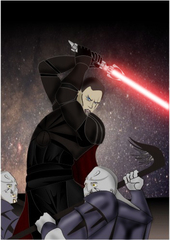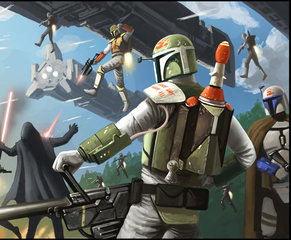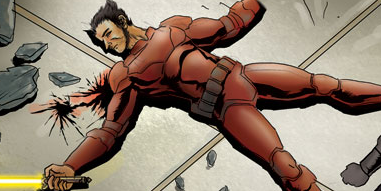Dark Brotherhood History 102
1. Introduction
This course continues the historical summation and analysis of the Dark Jedi Brotherhood’s history started in the first course of this series. Having recently severed contact with the Emperor’s Hammer during the Exodus, the Dark Brotherhood established itself on Antei and expanded its size and power, with a collection of significant setbacks, to the present day. Events are arranged chronologically by Grand Master, starting with Grand Master Firefox. Students are required to take Dark Brotherhood History 101 before taking this course.
2. A New Beginning
2.1 Twelfth Grand Master - Firefox - 11-16 ABY
2.1.1 Operation Tempest Bravo - 12 ABY
The Council of Seven organized a massive Exodus of Dark Brotherhood forces from the Aurora Sector, but despite a massive amount of support, they were entering a form of self-exile. The answer to their homelessness was obvious to all. Grand Master Firefox had already started to secretly lay the foundations of a new Dark Hall on Antei when he assumed the Iron Throne. He had also worked for two years to place a collection of agents within key offices of the Emperor’s Hammer and Imperial Remnant. During the year 13 ABY, hours after the Exodus, Operation Tempest Bravo launched.
Hundreds of millions of credits were siphoned from the Hammer and Remnant while key supply routes were redirected to Brotherhood forces adrift in space. These resources allowed the Brotherhood to sustain itself in the coming months, and the invaluable actions of these agents cannot be understated.
2.1.2 A Brotherhood Rebuilt
Meanwhile, Grand Master Firefox proceeded immediately to the Antei System. Having freed themselves of the Hammer’s oppression, Brotherhood forces from all clans were unusually allied as they conquered both the Antei and Antares Systems before each moved on to establish its own dominion in nearby systems. The last three years of Firefox’s reign as Grand Master were prosperous ones as the Brotherhood established its dominion and started to rebuild its ranks and lore.
This optimism and success was temporarily halted when construction on Antei reawakened the ancient Sith Lord Okemi and the corruption that had driven him insane three thousand years prior. The corruption, known as the Nameless Ones, used Okemi to spread itself to the consciousness of key Brotherhood leaders. The Brotherhood was thrown into civil war, and only when Grand Master Firefox pushed the consciousness back into its timeless sleep did the conflict subside.
2.2 Thirteenth Grand Master - Jac Cotelin - 16-20 ABY

Satisfied with his reign and the state of the Brotherhood three years after the Exodus, Firefox stepped down from the Iron Throne. In his place rose his Deputy Grand Master, Jac Cotelin. Similar to his first reign, Cotelin was powerful and popular as a leader. He united the various factions of the Brotherhood to work together either through partnership or conquest, including a Krath and Obelisk Rite of Supremacy that saw the Brotherhood’s dominion expand even further.
Both of Cotelin’s tenures as Grand Master included major reforms to the structure of the Brotherhood. Before the Exodus, he was instrumental in implementing the early designs of the Clan and House system still used today. During his second term, he initiated the controversial Dictum of Two Skies in 19 ABY that saw Clans Exar Kun and Satal Keto, weakened after multiple incursions with the pirate group Crimson Tide, merged into Clan Plagueis.
Near the end of his reign, the Brotherhood was thrown into another civil war when a clone of Jac Cotelin appeared. Clans divided behind one of the two Cotelins and battled for supremacy until the clone was slain by the true Cotelin and peace, so far as peace is possible for a collection of Dark Jedi, was restored.
3. Trials and Tribulations
3.1 Fourteenth Grand Master - Aristan “Sarin” Dantes - 20-24 ABY
Jac Cotelin remains one of the most successful and prolific Grand Masters in Brotherhood history, but over time he, like his predecessors, felt the call of a more personal study of the Force to be overwhelming. He nominated his protege Aristan Dantes, commonly known as Sarin, to replace him as Grand Master. Sarin, who had defected to the Brotherhood from what remained of the Emperor’s Hammer, would seize the Iron Throne during a time of equal prosperity and unease, and would lead the Brotherhood through its greatest adversity since the Exodus.
3.1.1 Invasion by an unknown alien species
Sarin’s reign started with a series of reforms that included the closure of both the Grand Master’s Royal Guard and Society of Envoys, both deemed outdated and no longer effective in a Brotherhood that was slowly losing its ability to act independently of the rest of the galaxy.

A previously unknown alien species was conquering all in their path, and Sarin recognized the need for the Brotherhood to prepare. In 20 ABY, he organized a military exercise to train and evaluate the clans’ readiness to face an outside threat. The exercise was successful, but in the closing moments, with the majority of Brotherhood leadership convened on and around Antei, the aliens attacked.
The initial assault surrounded the majority of the Brotherhood and clans’ fleet, forcing them to retreat into the Shroud where they operated without coordination, constantly reacting to the alien forces. Six days passed, during which the Deputy Grand Master Muz Ashen was captured, before Grand Master Sarin realized the Brotherhood was outmatched and defeated. He initiated the Braata Option, signalling a mass exile from the Antei System and effectively ceding control to the aliens.
The Brotherhood was homeless for the first time since the Exodus, and Antei was not the only loss. With the majority of clan forces trapped in the Shroud, the aliens had launched strikes on the Jusadih System of Clan Plagueis, Cocytus System of Clan Scholae Palatinae, and Rybanloth System of Clan Taldryan, the latter of which having only recently been awarded to Clan Taldryan for their victory during the military exercise. Jusadih was severely damaged while Cocytus was completely overtaken, and the clans would spend several years reestablishing their control.
3.1.2 A Wandering Brotherhood
For nearly three years, the Brotherhood operated from its fleet. The supreme organizational skills of Grand Master Sarin allowed operations to continue, but just as during the Exodus, the Brotherhood craved a home. The clans reclaimed their independent territories, and the Shadow Academy continued to train recruits from the Arcanum while Sarin bided his time and allowed their strength and anger towards the aliens to build. Then, in 21 ABY, he returned to the Antei System.

3.1.3 Unification - 21 ABY
The combined forces of the Dark Jedi Brotherhood, led by Grand Master Sarin and his Shadow Hand Muz Ashen, did not find the aliens on Antei. They found, instead, a fundamentalist Jedi sect led by Jedi Master Omancor Crask, who had conquered the planet after using a biological weapon to wipe out the alien occupiers. The Brotherhood was inspired to even greater fury over the presence of Jedi and immediately waged war against Crask and his army.
The battle would prove victorious, but at great cost. Omancor Crask revealed himself to be a fraud and truly Darth Carnus, a student of Darth Krayt’s One Sith, and engaged Grand Master Sarin in a vicious duel aboard the orbiting Exodus that continued through the ship’s crash landing on Antei. Ultimately, Crask struck down Grand Master Sarin only to be killed by his Jedi apprentice, who was angered by Crask’s betrayal as a Sith. Crask’s forces were defeated, and the Brotherhood reclaimed control of Antei, but at the heavy cost of one of its strongest leaders and Grand Masters.
4. Modern Times
4.1 Fifteenth Grand Master - Muz Ashen
4.1.1 Trials by Fire
Upon Sarin’s death, Muz Ashen immediately assumed the position of Grand Master, consolidating his power among the clans through his construction of conflict as a means of keeping the clans of the Brotherhood more occupied with each other than his control over them. This started with a Rite of Supremacy in which the clans and the recently formed Independent House Revan battled for control over the newly discovered planet Salas V. House Revan would rocket to success, proving its might against the more established clans and inspiring resentment among many of the Brotherhood. The tactic played well to Grand Master Ashen’s favor as the clans looked to each other more than the Dark Council and Star Chamber.
Muz’s trial by fire policy would again be implemented when he organized a war between the three orders of the Brotherhood: Sith, Krath, and Obelisk. The latter would emerge the victors and inspire further tension and frustration between not only clans but orders as more and more alliances were formed to combat the growing number of enemies being created. Further anger was inspired when Muz reorganized all clans into independent houses. While Arcona and Naga Sadow were soon after granted clan-hood due to their size and strength, their rivals remained houses. The Grand Master’s message was clear - his respect must be earned.

4.1.2 House Odan-Urr and New Tython - 28 ABY
The culmination of Muz’s manipulation of the Brotherhood’s anger came in 28 ABY but originated two years earlier when the Grand Master accepted the first group of Jedi into the Brotherhood as House Odan-Urr. The Jedi were discovered by Brotherhood agents having colonized a planet they named New Tython. This offshoot of the Jedi was not directly connected to Luke Skywalker’s New Jedi Order. The Dark Council surprised both sides when it decided to accept the Jedi as vassals of the Brotherhood, however, and both the clans and houses, as well as Jedi, were intensely suspicious of Muz’s motivations.
His goal seemed to reveal itself when he led a massive Brotherhood invasion of New Tython, channeling the charged anger of the Brotherhood into Dark Side strength that the Jedi, led by Master Ji, were unable to combat. The tide turned when the lost Jedi Michael Halcyon, brother of Deputy Grand Master Halcyon Rokir Taldrya, arrived with a Mandalorian force at his back, balancing the opposing sides. The battle was hard fought, but ultimately Michael Halcyon was killed by his brother while Muz defeated his former Jedi master. The temples of House Odan-Urr were left burning at the feet of Jedi Ji, as the Grand Master decided not to wipe out the Jedi but leave them having learned their subordinate status to the Brotherhood.
4.1.3 The Return of Zoraan - 30 ABY

While the Brotherhood busied itself on New Tython, an ancient force returned to Antei after years of slumber. Grand Master Archibald Zoraan, thought dead after his pre-Exodus destruction of the Dark Hall, revealed himself through a terrible Force plague that swept across Brotherhood ranks. The plague rendered the infected void of the Force and vulnerable to defeat. Among the casualties was former Grand Master Chi Long, gunned down by troops after he was unable to use the Force to stop them.
Zoraan attacked the Brotherhood after the spread of the plague had broken out into civil war. Zoraan would, in time, be definitively killed by Muz Ashen, and a solution to the Horizons Plague was discovered and distributed, but the damage was done. Clan Plagueis’ home in the Jusadih System was besieged by biochemical warfare that rendered the capital planet, Kapsina, lifeless.
4.2 Sixteenth Grand Master- Darth Pravus (32-36 ABY)
4.2.1 A New Order - 33 ABY
Upon Darth Pravus’ ascension to Grand Master, one of the first things he set about was the destruction of the remnants of the Krath and Obelisk orders, as well as eliminating several untrustworthy alien species from the Brotherhood. He did this through the formation of the Inquisitorius, which was tasked with removing undesirable elements.
To further strengthen the forces of the clans, for the first time, non-Force sensitives were allowed to join their ranks. In a final radical decision, the Grey Path is finally recognized. Beyond that, Pravus implemented a registry of ownership for both personal and clan assets. Some claim this is so the Inquisitorius has an easier job, but the truth is that this is merely to prevent items from falling into the hands of undesirable elements.
With his power base now secure, Pravus forms the Iron Legion, combining forces from the old military systems into one new force. With that, and the armada he has amassed, he strikes out at two targets: New Tython, the seat of the Jedi power in the Brotherhood, and Arx, to establish a new base of operations.
4.2.2 A New Foe Rises - 35 ABY
Six years earlier, the Fleet Admiral of the Brotherhood, Rath Oligard had suddenly vanished, following the death of his family on an uncharted planet. It turned out he had been spending that time plotting revenge, and he returned at the lead of a previously unknown organisation, the Collective. Hundreds of small-scale engagements over several weeks ultimately led to a full battle at Nancora, and the destruction of Pravus’ flagship, the Suffering.
The next couple of weeks see the various clans score several victories, but this turned out to be exactly what Oligard had planned, as he eventually seems to flee, only to strike at the homeworlds of various clans. His knowledge of the Iron Navy was more than sufficient to predict that he could lure enough clan assets away from their homeworlds, and then strike when they were weakest. This led to severe casualties in every clan, although one clan stands out among the rest in terms of damage: Tarentum, a clan with a long and proud history, suffered such catastrophic damage that it was no longer able to recover. It was disbanded, and its assets and members sent to reinforce other clans. Other clans lost their homeworlds, fleets, armies, or ancient artifacts. This led to a period of consolidation, and, for the first time in ages, a fragile alliance between the clans as they focused on a new and common enemy.
This also caused a change of leadership, with Darth Pravus abdicating his position as Grand Master, with his apprentice, Telaris ‘Mav’ Cantor taking his place.
5. Conclusion
The Brotherhood had been weakened, yet Muz saw similarities to the Brotherhood’s precarious position after reclaiming Antei from the aliens and Crask. He decided to use the same tactics as before to unite and rebuild the Brotherhood through that which it knew best - war; and he set his sights on the holy land of the Dark Side - the Sith worlds.
Pravus’ reign saw the rise of a new institution, the Inquisitorius, and a new enemy, the Collective. It also saw battles on a scale previously unheard of, and the closure of a clan.
The history of the Dark Jedi Brotherhood is one of birth, conquest, conflict, and renewal as it continues to reinvent itself to match the context of its times. The Brotherhood has seen many Grand Masters, many clans, houses, and a fair share of enemies both from within and without that seek to control or destroy. The Brotherhood is, in the end, something of an anomaly - a successful alliance of Dark Jedi who often operate selfishly yet band together in times of great stress to maintain their independence. Most importantly, the Brotherhood’s history is not over. Students are encouraged to expand their research through the DJBWiki, including those articles linked in this course, as well as revisit the course as it is updated in the future.
Please log in to take this course's exam